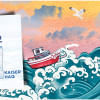Revisiting ‘Chobir Deshe, Kobitar Deshe’

Sunil Gangopadhyay's Chhobir Deshe, Kobitar Deshe (Ananda Publishers, 1991) is a book that the author wrote during his five trips to France, along with his limited experiences in other countries. However, this book cannot be simply called a travelogue because it contains a vast repository of the author's experiences regarding French art, literature, and tradition.
In this book, the author appears as a travel enthusiast, sometimes an essayist, sometimes a translator of French poetry, and sometimes a lover. He starts each chapter of the book with a translation of a poem by a French author. The beginning of the book also covers a significant portion of the author's first US immigration biography, where he is introduced to Margaret, a golden-haired French girl.
Reading the book, I too embarked on a journey through Chhobir Deshe, Kobitar Deshe in search of Margaret because I had previously read Sunil's romantic novel Shudur Jharnar Jole (Ananda Publishers India, 1976) in which Margaret's distance from the author extended from India to far-off America. So I picked up the book with the hope of encountering Margaret again within its pages, and I did indeed find her in approximately half of the book.
Through Margaret, the author delves deep into French art and literature. Margaret, a lover of poetry, frequently recited poems during their conversations and reviewed them. She would even forget her hunger at the end of the month by reciting amusing poems and it seemed that poetry was her passion.
In one of the poems, by a poet named Guillaume Apollinaire Shakuntala is mentioned, which sparked Margaret's interest in knowing the whole story of Shakuntala from an Indian. This poem establishes the author's connection to Margaret, who then introduces Sunil Gangopadhyay to renowned French poets and their poetry, such as Rabelais, Verlaine, Baudelaire, Mallarmé, Valéry, Apollinaire, and Anne Marie.
Margaret was the author's companion on his first trip to France. She introduced the author to French painters such as Degas, Monet, Manet, Renoir, Gogan, Matisse, Rouault, Picasso, and their artworks and also took him to the Palace of Versailles, enriching his knowledge by sharing the history, traditions, and myths of France.
The book also mentions the American poet Allen Ginsberg, who was a friend of Sunil. Hearing this name reminded me of the young man from 1971 who wrote the song "September on Jessore Road" after visiting the refugee camps during the Liberation War and witnessing their suffering. Through his song, he sought help for Bangladeshi refugees from around the world.
On the author's second trip to France, he was accompanied by his wife, Swati, who was also passionate about French culture and had learned the French language. By then, Margaret was lost to the unknown but the author's cry for her can be seen till the end of the book. Despite her absence, the author continued to visit France repeatedly, making it his second homeland.
During his next four trips, the author was accompanied by friends like Asim from France, Bhaskar from London, and Badal, the publisher of Ananda Publishers from India.
The book captures all the enjoyable experiences of travelling, and the food they ate, and provides descriptions of France's seas. While reading the book, it felt like I was accompanying Sunil and his friends, sharing their enjoyment of the seas, museums, and all the places they visited.
Chhobir Deshe, Kobitar Deshe is sure to pique the interest of many in the realm of painting. The book encompasses various facets of French painting and movements including the Impressionist Movement. If someone were to travel to France, this book would be a good guide. Additionally, Margaret is a remarkable character. Throughout my reading journey, I remained hopeful that she would return in the end, and that the fate presumed for her would prove untrue.
The author tries to avoid discussing Margaret in front of his friends during the subsequent four trips, but his intense desire to find her is repeatedly evident in the book. In every line of the book, I was on the lookout for a girl named Margaret.
While reading the travelogues of the author from his 60s and 70s, I found myself frequently transported to the centuries he talks about. Sunil's poetry translations, essayistic descriptions of art and literary traditions, and memoirs make the book a blend of a travelogue, essay, and autobiography in multiple ways.
Any reader can pick up this diverse work by Sunil to savour a variety of experiences. However, it is advisable to read this book with a little more time and attention, as it may be challenging to understand otherwise.
Md Abbas is a reporter to The Daily Star.

 For all latest news, follow The Daily Star's Google News channel.
For all latest news, follow The Daily Star's Google News channel. 











Comments